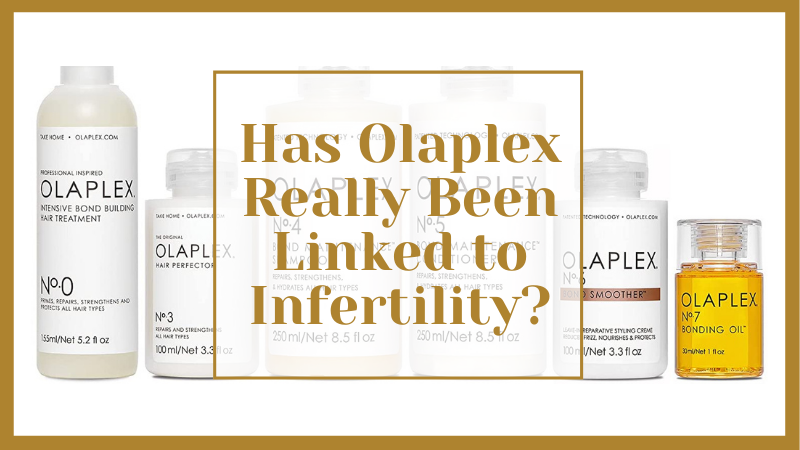You’ve probably heard of Olaplex. It’s the super pricey, super popular, hair line said to heal the damaged bonds of your damaged hair, especially if you’re a fan of bleaching (guilty as charged). Some people swear by Olaplex and are loyal to the entire line. Some people hate it and think it’s overrated. Whether you love it or hate it, you’ve probably seen it making headlines as it’s been found to have a link to infertility.
I’ll be honest, I do like some of the Olaplex products. I enjoy and currently use the conditioner (No #5), the bond treatment (No #2, only available to certified cosmetologists like me), and occasionally the at-home, deep conditioning treatment (No #3). I have tried all of the other products in the past, but none of the rest made in into my regular hair routine.
Since I used their products regularly, including No #3, during my last two pregnancies, still use several of their products today and am hoping to try for another baby this summer, I was very worried when I started seeing the headlines about Olaplex being linked to infertility. I try to be extra cautious during pregnancy “just in case,” and even though I know my babies are perfectly healthy, I had this momentary fear of “oh, crap.” So, I knew I had to get some answers, and this is what I’ve learned.
Facts About Olaplex’s Link to Infertility
Fact #1: The entire Olaplex product line is not under fire. It is one product in specific, the No 3 Hair Perfector (aka the at-home deep conditioning treatment). This product contained an ingredient, lilial, which has been linked to infertility.
Fact #2: Lilial has never been tested on humans, only animals during a study where it was digested by rats, mice, and dogs. In relatively high concentrations it did cause an adverse effects in reproductivity, according the the Scientific Committee on Consumer Safety (SCCS).
Fact #3: The interest in Lilial began in 2015, and it was initially concluded to be safe. The above study was performed during the end of 2017 and beginning 0f 2018, and the results of the study were published in 2019.
Fact: #4: The EU officially labeled lilial as a “reprotoxic” in september 2020 with a March 2022 deadline for phasing out all products containing this chemical. This is why Olaplex was using the ingredient in any of their products in the first place. It is a fairly new discovery and it takes some time to adjust to a new discovery once it’s been made. They didn’t set out to create a product with an already banned ingredient in it, like some people have theorized.
Fact #5: The US has not banned lilial and permits the use of this ingredient still, but Olaplex has decided to stop using the ingredient worldwide as a proactive precaution.
Fact #6: Although Olaplex is the company that is most under-fire for lilial, there are many other companies that are using this ingredient as well. If they are US based, they may not be concerned with phasing out this ingredient as there is no ban on the ingredient in the US. If you’re really worried about lilial, you’ll have to do your own research and check your other products for this ingredient as well including shampoos, conditioners, other hair care products, perfumes, lotions, and body washes, among others. It is also a naturally occurring ingredient in chamomile essential oil. The ingredient is also found in laundry detergent and household cleaners, although the risk in these products isn’t as significant as it shouldn’t really be coming into contact or being absorbed by your skin.
Fact #7: “At Olaplex, lilial was previously used in small amounts as a fragrance in No 3 Hair Perfector. It is not an active or functional ingredient,” a spokesperson for Olaplex said. Lilial is/was present in No 3 in small amounts, 0.1 percent to be exact. This small dose is mostly likely not enough to cause any problems, especially since it is applied to the hair and does not penetrate deep into the skin, according to an anonymous cosmetic regulator found by independent.co.
Fact #8: It is more the long term use, and not the short term use, that poses the greatest risk. “A review by the European Union’s consumer safety regulators concluded that adding up small exposures over time could pose a health risk, particularly for individuals trying to conceive.”
Fact #9: Olaplex has already removed lilial from the No 3 Hair Perfector worldwide, starting with the EU issued a ban on the ingredient. If you live in the UK, No. 3 is said to have been removed from the shelfs in January. However, older versions of the product may still be around, especially if you live in other parts of the world. So you should check your products that you have at home, or before purchasing them in a store, to make sure you’re receiving the new version of the product.
In Conclusion:
I did check my products for this ingredient, because I buy products in bulk often and don’t really feel like it’s worth any risk to keep them around. Even though I feel like the risk isn’t as great as I was originally thinking it would be, I tend to go with a better safe than sorry approach. However, I still love the Olaplex products I use and will continue to use them.
I think the most importantly thing is to make sure that you’re checking the No. 3 product for lilial for the next year or so as I’m sure there will still be many places selling the old version of the product. Since Olaplex is working to remove this product going forward, I don’t think there will be anything to worry about in the future. I also feel that they are going to be extra cautious about their ingredients right now since they have just been under so much fire from this whole ordeal.
What about you? Are you an Olaplex user? Will you continue using their products after this? Let me know in the comments below.
Happy shopping,
The Empowered Shopper



